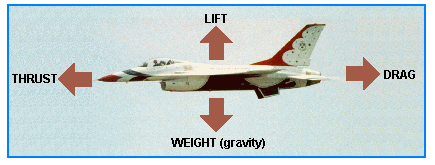 |
|||||
| Home | Research | For Teachers | HISTORY Level 1 Level 2 Level 3 |
PRINCIPLES Level 1 Level 2 Level 3 |
CAREER Level 1 Level 2 Level 3 |
| Gallery | Hot Links | What's New! | |||
| Web Administration and Tools | |||||
 |
|||||
| Home | Research | For Teachers | HISTORY Level 1 Level 2 Level 3 |
PRINCIPLES Level 1 Level 2 Level 3 |
CAREER Level 1 Level 2 Level 3 |
| Gallery | Hot Links | What's New! | |||
| Web Administration and Tools | |||||
![]()
There are four forces acting on an airplane in flight. These are thrust, drag, lift and weight(gravity).
1. THRUST.
The force exerted by the engine and its propeller(s),  which pushes air backward with the object of
causing a reaction, or thrust, of the airplane in the forward direction.
which pushes air backward with the object of
causing a reaction, or thrust, of the airplane in the forward direction.
2. DRAG. The resistance of the airplane to forward motion directly opposed to thrust.
3. LIFT. The upward force created by the wings moving through the air, which sustains the airplane in flight.
4. WEIGHT. The downward force due to the weight(gravity) of the airplane and its load, directly opposed to lift.
When thrust and drag are equal and opposite, the airplane is said to be in a state of equilibrium. That is to say, it will continue to move forward at the same uniform speed. (Equilibrium refers to steady motion and not to a state of rest, in this context)
If either of these forces becomes greater than the force opposing it, the state of equilibrium will be lost. If thrust is greater than drag, the airplane will accelerate or gain speed. If drag is greater than thrust, the airplane will decelerate or lose speed and consequently, the airplane will descend.
Similarly, when lift and weight are equal and opposite, the airplane will be in equilibrium. If lift, however, is greater than weight, the airplane will climb. If weight is greater than lift, the airplane will sink.
The information in this section has been extracted from several sources. Those sources have been contacted and permission to use their material on our site is pending. However, the format in which this material has been presented is copyrighted by the ALLSTAR network.
Send all comments to ![]() aeromaster@eng.fiu.edu
aeromaster@eng.fiu.edu
© 1995-98 ALLSTAR Network. All rights reserved worldwide.
Updated: February 23, 1999